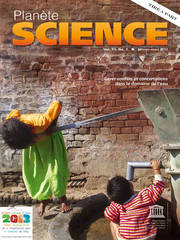Planète Science par thème : Sites protégés de l’UNESCO
- Memory of the Earth (2013, EN), on the stories that geoparks can tell us about the history of our planet as concerns climate change, the drift of the continents, evolution, natural disasters and cosmic visitors
- Protecting a land of fire and ice (2013, EN, ES, GER), on efforts by Cape Horn Biosphere Reserve in Chile to promote sustainable tourism, as climate change takes its toll in the Patagonian Icefields, the third-biggest frozen ice mass after Antarctica and Greenland
- A Garden in the Desert (2013, AR, EN), on a survey of Qatar which found that vegetation was recovering in parts of Qatar, even if desert rangelands and coastal areas remain in poor condition
- Rebirth of a Hunter (2013, EN), on how a hunter in Vietnam’s Cat Ba Biosphere Reserve hung up his rifle to become a forest ranger after realizing that his prey, the langur (a primate), was on the brink of extinction
- Putting a Price on Conservation (2012, EN, ES, FR), on how the Serra do Espinhaço Biosphere Reserve in Brazil is rewarding municipalities which protect biodiversity and ecosystems in the world’s most intensely mined biosphere reserve
- Tales Set in Stone (2012, EN, ES, FR), retracing the impact of climate change and natural disasters over the past 30 000 years on human civilizations living around the Black and Mediterranean Sea basins
- China’s Palaeotreasure Trove (2012, EN, ES, FR), on China’s network of more than 300 geoparks
- Striving for a Better Tomorrow in Mujib (2012, EN, ES, FR), on the new Mujib Biosphere Reserve in Jordan
- Forty Years of Field Laboratories in Sustainability (2011, EN, ES, FR, RU), tracing the 40-year history of UNESCO’s Man and the Biosphere Programme, which seeks to reconcile humanity with nature
- The Adventures of Patrimonito (2010, EN, ES, FR, RU), an adventure of the hero invented by the World Heritage Centre to alert children to environmental issues affecting natural and cultural World Heritage; this time, our hero comes to the aid of the animals living on an island invaded by pigs
- The Bushbruckridge Healers’ Path to Justice (2010, AR, EN, ES, FR, RU), on how traditional healers in the Kruger to Canyons Biosphere Reserve in South Africa will benefit from a revolution in environmental law due to be adopted by the United Nations
- Darwin Lives! (2009, AR, EN, ES, FR, RU) on the 19th century journey which shaped Charles Darwin’s revolutionary theory on the evolution of species and how geoparks and some World Heritage sites bear testimony to the evolution of life on Earth.
- Ulugh Beg: the Scholar on the Throne (2009, AR, EN, ES, FR, RU), on the sole astronomer in history to rule a mighty state, during the 15th century, the capital of which, Samarkand, lies in modern-day Uzbekistan
- Taking a Step Back (2009, AR, EN, ES, FR, RU), on why Malindi Watamu Biosphere Reserve in Kenya and Braunton Burrows–North Devon’s Biosphere Reserve in the UK have both concluded that retreat is the best policy in the face of sea-level rise
- Megacities of Tomorrow (2008, AR, EN, ES, FR, RU), forecasting how the geosciences will shape the world’s most populous cities in the decades to come
- Geotropical Paradise (2008, AR, EN, ES, FR), on Langkawi Geopark, a member of UNESCO's ad hoc Global Geopark Network
- Mayangna Knowledge Deep in the Heart of Mesoamerica (2008, AR, EN, ES, FR, RU), the Mayangna and Miskito peoples’ struggle to protect one of the last extensive areas of Central American tropical rainforest, in Boswas Biosphere
- Rhön’s Gastronomical Ambassadors (2008, EN, ES, FR, MLY, RU), on the Rhön Biosphere Reserve in Germany, which has turned the art of local gastronomy into a socio-economic success
- Saving the Remaining Wildlife in Darfur (2007, EN, ES, FR, RU), on a survey of the rapidly vanishing wildlife in Radom Biosphere Reserve, the victim of the proliferation of automatic weapons and refugees as a result of the armed conflict in Sudan
- The Heat is On for Australia’s Forests (2007, EN, ES, FR, RU), on the impact on Australian biodiversity of projected climate change
- Taking the Temperature of Mountains (2006, EN, ES, FR), on a project to monitor climate change and other forms of global change in selected biosphere reserves in mountainous regions
- Saviours from Space for Siberia’s Frozen Tombs (2006, EN, ES, FR, RU), on using remote sensing to identify buried tombs from a culture dating back 2500 years, in a race against time before melting permafrost destroys them
- Using the Sun to Quench their Thirst (2006, EN, ES, FR, RU), on a project in Omayed Biosphere Reserve in Egypt to desalinate groundwater at the population’s request
- The Pastoralists of Wadi Allaqi (2003, EN, FR), on the techniques pastoralists have developed in Wadi Allaqi Biosphere Reserve to survive in a region where it only rains every few years; introduces the research done by the UNESCO-Cousteau Ecotechnie Chair within the biosphere reserve
- Protecting Himalayan Biodiversity (2002, EN, FR), on a study planned for Nanda Devi Biosphere Reserve in India on the virtues of large-scale cultivation of medicinal and aromatic plants
See also Biodiversity and land management and Climate change

